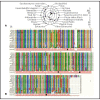Molecular modeling and in silico characterization of Mycobacterium tuberculosis TlyA: possible misannotation of this tubercle bacilli-hemolysin
- PMID: 21443791
- PMCID: PMC3072309
- DOI: 10.1186/1472-6807-11-16
Molecular modeling and in silico characterization of Mycobacterium tuberculosis TlyA: possible misannotation of this tubercle bacilli-hemolysin
Abstract
Background: The TlyA protein has a controversial function as a virulence factor in Mycobacterium tuberculosis (M. tuberculosis). At present, its dual activity as hemolysin and RNA methyltransferase in M. tuberculosis has been indirectly proposed based on in vitro results. There is no evidence however for TlyA relevance in the survival of tubercle bacilli inside host cells or whether both activities are functionally linked. A thorough analysis of structure prediction for this mycobacterial protein in this study shows the need for reevaluating TlyA's function in virulence.
Results: Bioinformatics analysis of TlyA identified a ribosomal protein binding domain (S4 domain), located between residues 5 and 68 as well as an FtsJ-like methyltranferase domain encompassing residues 62 and 247, all of which have been previously described in translation machinery-associated proteins. Subcellular localization prediction showed that TlyA lacks a signal peptide and its hydrophobicity profile showed no evidence of transmembrane helices. These findings suggested that it may not be attached to the membrane, which is consistent with a cytoplasmic localization. Three-dimensional modeling of TlyA showed a consensus structure, having a common core formed by a six-stranded β-sheet between two α-helix layers, which is consistent with an RNA methyltransferase structure. Phylogenetic analyses showed high conservation of the tlyA gene among Mycobacterium species. Additionally, the nucleotide substitution rates suggested purifying selection during tlyA gene evolution and the absence of a common ancestor between TlyA proteins and bacterial pore-forming proteins.
Conclusion: Altogether, our manual in silico curation suggested that TlyA is involved in ribosomal biogenesis and that there is a functional annotation error regarding this protein family in several microbial and plant genomes, including the M. tuberculosis genome.
Figures





References
MeSH terms
Substances
LinkOut - more resources
Full Text Sources

